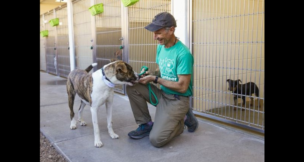Volunteers take census of people with no place to call home
Arizona Capitol Reports Staff//February 6, 2009//[read_meter]
Volunteers take census of people with no place to call home
Arizona Capitol Reports Staff//February 6, 2009//[read_meter]
Jessica Berg steered slowly into the alley, the headlights briefly catching a man in a long white beard. His clothes looked old, a bit disheveled.
He stood his ground, looking like he had no plans for the future — let alone his next move.
Berg added him to the homeless tally. She was almost apologetic.
“We’re stereotyping people,” Berg said.
It’s a judgment call, but Berg’s is based on experience. She is executive director of Lodestar Day Resource Center, where the homeless can enjoy a snack, pick up their mail, find a job and receive behavioral health services. The center is on a campus for the homeless, less than a mile from the Capitol. A nearby shelter offers a secure place to sleep.
On this night, Berg counted the people still out in the cold. She wasn’t alone. On Jan. 27, volunteers nationwide combed alleys, streets and rural roads, adding up the homeless. The U.S. Department of Housing and Urban Development will use the tally to allocate federal money for homeless-housing programs.
At stake in Maricopa County is an estimated $21 million.
Berg was one of 300 volunteers to blanket the city of Phoenix. In their own vehicles, they fanned out from the Bethany Bible Church on North Seventh Avenue. For safety and extra sets of eyes, they went in teams.
Each team was assigned a section.
Berg’s team included Elinor Gregorio and Beth Pyne. They’re counselors at St. Joseph the Worker, a nonprofit group that helps homeless and low-income people find jobs. St. Joseph is housed in Lodestar.
The three headed out shortly before 8 p.m. Their area was a grid from McKinley south to Van Buren and from Seventh Avenue east to Central. It included the downtown bus terminal and the YMCA.
Berg pulled up to a Circle K at Fillmore and First Avenue. At orientation, volunteers had been advised to check out the mini-markets. Gregorio and Pyne entered the store.
A man standing near the entrance, Berg noted, was a candidate for the count. He appeared to be eating dinner, soup from a cup. Next to him was a large backpack.
On the other hand, Berg said, his shoes were in good shape. The homeless do a lot of walking, and often their footwear takes a toll.
Gregorio and Pyne returned to the car. They saw no one in the store who fit the template: disheveled, unwashed. They were stereotyping perhaps, but it’s a fact of life. Outside of a shelter, the hardcore homeless don’t have access to showers. And many of them own little more than the unwashed shirt on their back.
As for the man outside, Berg discussed his status with Gregorio and Pyne. The nice shoes were an issue. But the team erred on the side of inclusion.
“He’s standing up, eating a cup of soup – so I would count him,” Berg said.
Well-fed, well-clothed, good shoes. He appeared in no need of immediate help. If Berg had come across somebody in desperate straits, she’d note the location and notify a homeless outreach team – old hands at encouraging people to come in and seek assistance.
Many take the offer. Some might decide to turn things around, look for work. They might end up talking to Gregorio and Pyne, who can help them find jobs. The counselors search job banks. They stage practice interviews.
It’s not always easy. Many homeless people have mental illness. Many are alcohol or drug abusers. Some are all three. Even for those who turn things around, it’s difficult to find work in a bad economy.
Now people with better resumes are competing for the same jobs, Pyne said.
“I’ve had a hundred people say, ‘I’ll dig ditches. I’ll wash dishes,” she said.
Two of them said they had master’s degrees.
As Pyne spoke, Berg pulled up behind a city bus. A man at the stop didn’t get on. He just hung around, looking at nothing in particular. He went down as homeless.
By last year’s count, some 8,000 people in Maricopa County called the street their home. But many more are out there, says Cathy Walsh, Human Services coordinator for the city of Phoenix. The number of homeless people counted this year will be released in March.
They’re the chronic homeless. They know their way around. And how not to be seen. And counted.
















